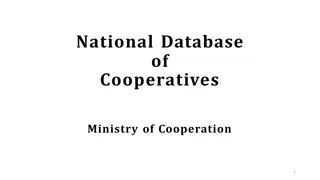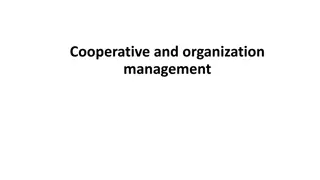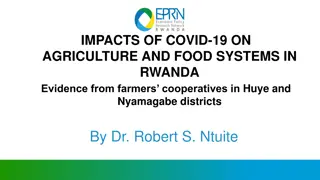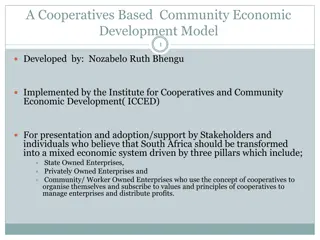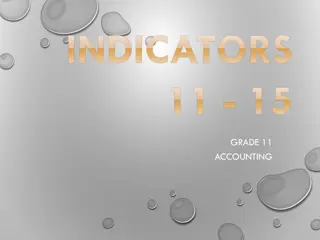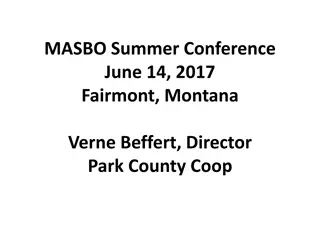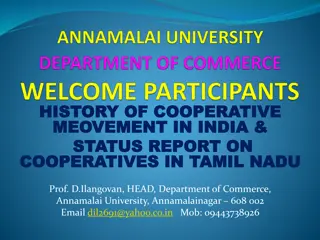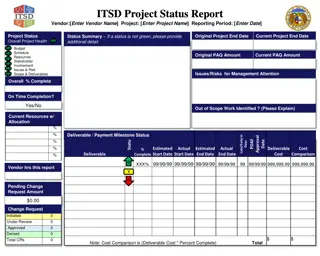Consolidating Statistics on Cooperatives: Current Status, Opportunities, and Challenges
This presentation discusses the current status of cooperatives, focusing on the opportunities and challenges in statistics related to the social and solidarity economy. It covers background information, guidelines, definitions, structures, and key initiatives towards improving national statistics on cooperatives. Various organizations and conferences play a crucial role in shaping the statistical landscape for cooperatives. Efforts such as the Global Census on Cooperatives and global mapping initiatives aim to enhance the understanding and data availability on cooperatives worldwide.
Download Presentation

Please find below an Image/Link to download the presentation.
The content on the website is provided AS IS for your information and personal use only. It may not be sold, licensed, or shared on other websites without obtaining consent from the author. Download presentation by click this link. If you encounter any issues during the download, it is possible that the publisher has removed the file from their server.
E N D
Presentation Transcript
Consolidating statistics on Cooperatives current status Opportunities and Challenges of Statistics on the Social and Solidarity Economy Brussels, 4 November 2019 Manpreet Singh Senior Statistician, ILO Young Hyung Kim Technical Specialist on COOP & SSE development, ILO
Outline Background . Guidelines concerning Statistics of Cooperatives Next Steps
Background - Terms, Definitions, Structures Cooperatives: ICA (1995), ILO Recommendation no.193 * 7 principles of coop used as a basic reference for its statistical definition. . SSE: Social and Solidarity Economy * Coops is one of the examplary organization in SSE. COPAC: Committee of Promotion and Advancement of Cooperatives (1973), ILO, UNDESA, FAO, WFO, ICA ILC: International Labour Conference ICLS: International Conference of Labour Statistician
Background - Terms, Definition, Structures UN Statistical Commission ILO -Labour UNCTAD -Trade . UIS -Education UNWTO -Tourism Committee for the coordination of statistical activities (CCSA) WHO -Health WMO -Climate ITU FAO -Agriculture Telecommunications OTHER OTHER
Background - Terms, Definition, Structures Conventions & Recommendations: adopted by ILC * conventions: legally binding (e.g. Labour Statistics Convention 1985 (no. 160) recommendations: non-binding (e.g. Labour Statistics Recommendation 1985 (no.170) . Resolutions & Guidelines: by ICLS * resolutions: set standards on conceptual frameworks, operational definitions and measurement methodologies (Non-binding) guidelines: Provide guidance on very specific topic areas (Non-binding)
Background-Roads to the guidelines Year of foundation: ICA (1895), ILO COOP (1920), COPAC (1973), * (MOU for COPAC, 1973) assistance to coop movement in developing countries by; a) collect data and information needed as background material b), c) . ILO Recommendation 2002 (no. 193): national policies should seek to improve national statistics on cooperatives with a view to the formulation and implementation of development policies International Year of Cooperatives designated by UN (2012) 19th ICLS (2013): resolution concerning further work on statistics of coopertives
Background-Roads to the guidelines Global Census on Cooperatives (UNDESA, 2014) . A global mapping effort (ILO, 2015): to develop an inventory of existing data on cooperatives gathered by NSOs and other providers and/or producers Country case studies (11 by ILO, 2 by FAO, 2015 2016): to analyze country data collection methodologies, processes, instruments and definitions COPAC Technical Working Group (formed in 2016): commissioned by COPAC to reach to an int l standard by 20th ICLS, composed of experts from int l org, NSOs, state authorities
Background-Roads to the guidelines COPAC Technical Working Group on 11-12 May 2017: discuss Conceptual Framework on Measurement of Cooperatives and its Operationalization . COPAC Technical Working Group on 4 April 2018: discuss background papers for the core elements of the guidelines ~August 2018: drafted the agenda on the guidelines concerning statistics of cooperatives 20th ICSL in October 2018, 335th session of Governing Body of the ILO in March 2019
Guideline concerning statistics of cooperatives (adopted at 20th ICLS in 2018) Objectives and uses An adequate information base for descriptive, analytical and policy level work Number and type of cooperatives; member of cooperatives; work generated in cooperatives Economic contribution of cooperatives Reference concepts and definitions (R.193, 2002) A cooperative is defined as an autonomous association of persons and/or legal entities united voluntarily to meet their common economic, social and cultural needs and aspirations through a jointly owned and democratically controlled enterprise. Types of cooperatives Statistical units; Operational definitions; Work in cooperatives; Data collection and analysis ..
Guidelines types of cooperatives Type of cooperative Interest of members Type of member Producer cooperative Production activity Producer-members: - enterprises such as small agricultural or craft producers - may or may not be incorporated . Worker cooperative Work Worker-members Consumer/User cooperative Consumption Consumer-members: clients, family of clients, non-profit institutions, producers, corporations Multi-stakeholder cooperative More than one interest Producer-members Consumer-members Worker-members
Guidelines operational definitions The definition of cooperatives can be operationalized on the basis of four criteria: . A cooperative should be a formally established institutional unit (non-financial corporation, financial corporation or non-profit institution) A cooperative should be controlled democratically by its members according to the principle that each member has an equal vote Membership of the cooperative should be voluntary and non-restrictive Distribution of profits or surplus among the members is not directly linked to the capital contributed by each member
Guidelines work in cooperatives Work performed in cooperatives can be undertaken by members and by non-members and may include all forms of work. . Work within the scope of statistics on cooperatives includes work performed by members and non-members in: Cooperatives; Economic units that are members of a producer cooperative or multi- stakeholder cooperative; Subsidiary enterprises owned or controlled by cooperatives. Statistics on work generated in cooperatives, in particular statistics on employment, should be compiled and tabulated separately or disaggregated for each of these institutional settings.
Guidelines data collection and analysis Comprehensive statistics on cooperatives, members of cooperatives and jobs or work activities performed within the scope of statistics on cooperatives should be published on a regular basis, if possible at least every five years. . Statistics of cooperatives should be systematically tabulated, as follows: By the four main types of cooperatives, as well as by nationally specific sub-types where relevant and feasible; By branch of economic activity; By regions relevant to national purposes, including by urban and rural areas.
Sources of statistics on cooperatives: strengths and limitations Strengths Limitations . Registers Regular statistics for registered cooperatives Coverage? Double counting (of cooperatives, members and workers) Surveys of coops In-depth surveys on registered cooperatives Sample based on registers: coverage problems, double counting Establishment surveys Can cover enterprises which have the characteristics of cooperatives (registered or not) Requires an area-based survey to guarantee full coverage of small and unregistered enterprises May not be able to produce separate figures for cooperatives Household surveys Only source for statistics on members of cooperatives and workers engaged Cannot provide all data items needed (e.g. number of cooperatives)
. . Statistics on Cooperatives why am I so excited?
Next Steps To support stakeholders on having reliable, coherent and comparable statistics on cooperatives that are aligned with the recently released Guidelines concerning Statistics on Cooperatives, the following actions are being proposed based on resource availability: . A short informational video on the Guidelines concerning Statistics on Cooperatives A short informational brief about the Guidelines concerning Statistics on Cooperatives Summary report on country practices on Measuring Statistics on Cooperatives Manual on Measuring Statistics on Cooperatives 21st International Conference of Labour Statistics (ICLS)
. . .




